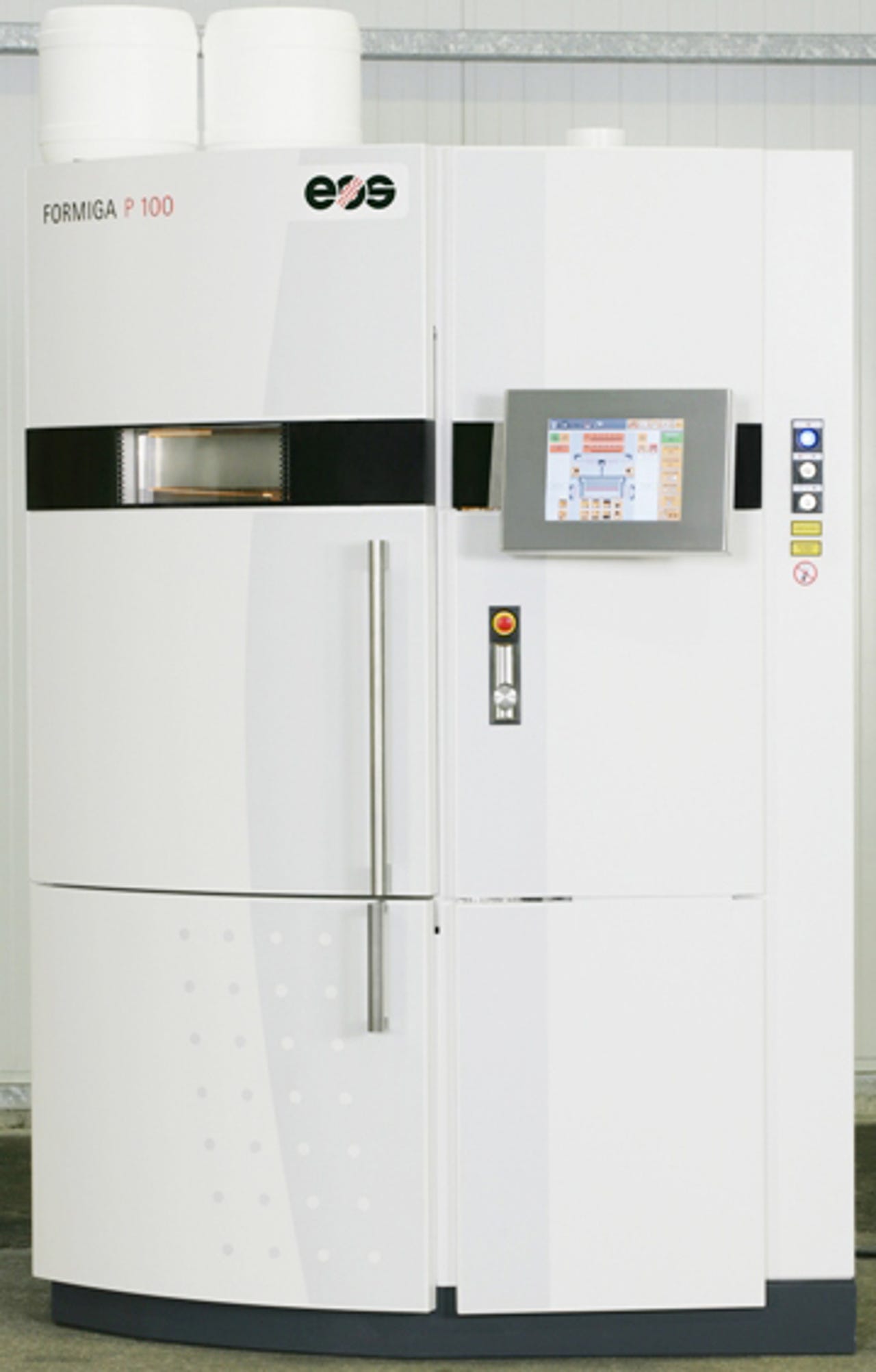Meet the printer that can print your car parts
3D printers are devices capable of creating solid, three-dimensional objects, from prosthetic limbs and miniature chess sets, to car and airplane parts.


1 of 7 Andy Smith/ZDNET
In Star Trek, the Starship Enterprise came equipped with a replicator able to rustle up a glass of whiskey - or whatever else its user fancied - at the touch of a button.
The closest we can get to that today are 3D printers: devices capable of creating solid, three-dimensional objects, from prosthetic limbs and miniature chess sets, to car and airplane parts.
One such 3D printer, made by a company called Electro Optical Systems, was on show at the Science Museum in London this week.
To create an object with the printer, a designer starts by drawing a 3D image using CAD software and saving it as a file that can be understood by the printer. Software on the printer then divides the image into multiple, super-thin layers.
A layer of powder, made out of either plastic, metal or sand, is then deposited in a container inside the printer. A laser in the top of the machine traces the outline of the base of the 3D image onto the powder, as seen on the next page. The laser's movements are precisely controlled to match the shape of the 3D image stored in the printer's memory and the heat from the laser fuses the powder, forming the bottom of the object.
A fresh coating of powder is then deposited and the next tier of the image is etched by the laser, fusing the next layer of the shape. This process - known as laser sintering - is repeated, building layer upon layer, until the object is complete, with the printer able to build an object at a speed of 15mm per hour.
Click here to see a video of the printer in action.
The closest we can get to that today are 3D printers: devices capable of creating solid, three-dimensional objects, from prosthetic limbs and miniature chess sets, to car and airplane parts.
One such 3D printer, made by a company called Electro Optical Systems, was on show at the Science Museum in London this week.
To create an object with the printer, a designer starts by drawing a 3D image using CAD software and saving it as a file that can be understood by the printer. Software on the printer then divides the image into multiple, super-thin layers.
A layer of powder, made out of either plastic, metal or sand, is then deposited in a container inside the printer. A laser in the top of the machine traces the outline of the base of the 3D image onto the powder, as seen on the next page. The laser's movements are precisely controlled to match the shape of the 3D image stored in the printer's memory and the heat from the laser fuses the powder, forming the bottom of the object.
A fresh coating of powder is then deposited and the next tier of the image is etched by the laser, fusing the next layer of the shape. This process - known as laser sintering - is repeated, building layer upon layer, until the object is complete, with the printer able to build an object at a speed of 15mm per hour.
Click here to see a video of the printer in action.
This gallery was originally posted on silicon.com.
Author: Nick Heath
Photo credit: Electro Optical Systems
2 of 7 Andy Smith/ZDNET
Here, the 3D printer's laser traces the outline of an object
Photo credit: Electro Optical Systems
Photo credit: Electro Optical Systems
3 of 7 Andy Smith/ZDNET
The process of 3D printing has traditionally been used by companies as a way of rapidly producing prototypes - around 80 per cent of 3D printers are used for this purpose.
However, a number of companies are starting to use the process to manufacture products, with the Williams F1 racing team and Bentley using it to make parts for their cars and Dyson using it to make its vacuum cleaners.
A laser sintering machine was used to print out the prosthetic leg - similar to the one seen above - worn by Michael Teuber, the Paralympic cyclist who won a gold medal in Beijing last year.
Photo credit: Nick Heath/silicon.com
However, a number of companies are starting to use the process to manufacture products, with the Williams F1 racing team and Bentley using it to make parts for their cars and Dyson using it to make its vacuum cleaners.
A laser sintering machine was used to print out the prosthetic leg - similar to the one seen above - worn by Michael Teuber, the Paralympic cyclist who won a gold medal in Beijing last year.
Photo credit: Nick Heath/silicon.com
4 of 7 Andy Smith/ZDNET
Here is a dental bridge that has been printed out by a laser sintering machine using a cobalt/chromium powder.
First a mold is taken of the patient's teeth, a 3D laser scan of which is turned into a CAD image that the printer can slice into layers.
The laser sintering then builds the bridge out of the metal powder layer by layer.
Show here on the left is a metal bridge that has been printed out but has not yet had a ceramic coating, which will make it look like it is made out of tooth enamel, applied. On the right is the finished, ceramic-coated bridge fitted to some teeth.
There are centers across Europe that are printing out crowns and bridges using the machines, including one in Newbury in the UK.
Photo credit: Nick Heath/silicon.com
First a mold is taken of the patient's teeth, a 3D laser scan of which is turned into a CAD image that the printer can slice into layers.
The laser sintering then builds the bridge out of the metal powder layer by layer.
Show here on the left is a metal bridge that has been printed out but has not yet had a ceramic coating, which will make it look like it is made out of tooth enamel, applied. On the right is the finished, ceramic-coated bridge fitted to some teeth.
There are centers across Europe that are printing out crowns and bridges using the machines, including one in Newbury in the UK.
Photo credit: Nick Heath/silicon.com
5 of 7 Andy Smith/ZDNET
The level of fine detail in the chess pieces on this tiny board shows how precisely the printer can control the laser.
While the machine on show at the Science Museum would set you back £150,000, a top-of-the-range machine that prints using a specialised form of plastic called peek, which is capable of withstanding high temperatures, would sell for £1m.
Photo credit: Electro Optical Systems
While the machine on show at the Science Museum would set you back £150,000, a top-of-the-range machine that prints using a specialised form of plastic called peek, which is capable of withstanding high temperatures, would sell for £1m.
Photo credit: Electro Optical Systems
6 of 7 Andy Smith/ZDNET
While the technology is too expensive for home use by consumers, they will soon be able to use it to customise trinkets for their homes.
A company called Digital Forming is about to launch software that large companies will be able to embed into their websites to allow their customers to tweak the designs of their products.
Consumers would be able to alter the shape and colour of objects using the online software and Digital Forming would then print off the product using a laser-sintering machine, allowing shoppers to create bespoke objects such as this lamp.
Photo credit: Nick Heath/silicon.com
A company called Digital Forming is about to launch software that large companies will be able to embed into their websites to allow their customers to tweak the designs of their products.
Consumers would be able to alter the shape and colour of objects using the online software and Digital Forming would then print off the product using a laser-sintering machine, allowing shoppers to create bespoke objects such as this lamp.
Photo credit: Nick Heath/silicon.com
7 of 7 Andy Smith/ZDNET
Here's another bespoke item for the home designed using the Digital Forming service. This chair-like sculpture was printed in four parts and then fitted together.
Photo credit: Nick Heath/silicon.com
Photo credit: Nick Heath/silicon.com
Related Galleries
Holiday wallpaper for your phone: Christmas, Hanukkah, New Year's, and winter scenes
![Holiday lights in Central Park background]()
Related Galleries
Holiday wallpaper for your phone: Christmas, Hanukkah, New Year's, and winter scenes
21 Photos
Winter backgrounds for your next virtual meeting
![Wooden lodge in pine forest with heavy snow reflection on Lake O'hara at Yoho national park]()
Related Galleries
Winter backgrounds for your next virtual meeting
21 Photos
Holiday backgrounds for Zoom: Christmas cheer, New Year's Eve, Hanukkah and winter scenes
![3D Rendering Christmas interior]()
Related Galleries
Holiday backgrounds for Zoom: Christmas cheer, New Year's Eve, Hanukkah and winter scenes
21 Photos
Hyundai Ioniq 5 and Kia EV6: Electric vehicle extravaganza
![img-8825]()
Related Galleries
Hyundai Ioniq 5 and Kia EV6: Electric vehicle extravaganza
26 Photos
A weekend with Google's Chrome OS Flex
![img-9792-2]()
Related Galleries
A weekend with Google's Chrome OS Flex
22 Photos
Cybersecurity flaws, customer experiences, smartphone losses, and more: ZDNet's research roundup
![shutterstock-1024665187.jpg]()
Related Galleries
Cybersecurity flaws, customer experiences, smartphone losses, and more: ZDNet's research roundup
8 Photos
Inside a fake $20 '16TB external M.2 SSD'
![Full of promises!]()